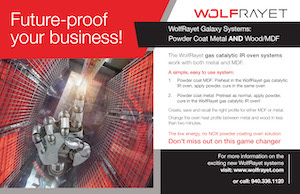More and more companies are asking for information about hardcoat anodizing.
 Larry ChesterfieldThese are usually manufacturers who have been sending certain parts they make to an outside source for hardcoating and are now considering bringing the anodizing in-house. Or they are anodizers who constantly get inquiries for hardcoat anodizing but don’t currently offer the process.
Larry ChesterfieldThese are usually manufacturers who have been sending certain parts they make to an outside source for hardcoating and are now considering bringing the anodizing in-house. Or they are anodizers who constantly get inquiries for hardcoat anodizing but don’t currently offer the process.
Nearly every large metropolitan area has companies that make aluminum parts that require hardcoat anodizing. Some rural areas, particularly in the larger Western states, may have an anodizer in a small town that might be able to attract business from a sparsely populated but very large area.
Whatever the situation may be, hardcoat anodizing continues to be in great demand.
Scores of Hardcoat Anodizing Processes
There are scores of hardcoat anodizing processes. Many are designed to satisfy very specific product performance requirements. The most widely used processes are the ones that can provide a wide range of performance characteristics for many diverse products without compromising quality. These processes might be favored by “job-shop” anodizers who must contend with many different part configurations and alloys from a variety of product manufacturers.
Here are some basic, versatile hardcoat processes that have been around for a long time. These, and numerous variations, form the basis of processes that are still in use today.
- The Martin Hard Coat process (MHC) is one of the earliest hardcoat anodizing processes. It works well on a wide range of alloys, including the 3000, 5000, 6000, and 7000 Series. Anodizing of 2000 Series alloys is generally limited to those with <3% copper and <7.5% silicon. Processing conditions are:
- 15% by weight (165 g/l) sulfuric acid at 32°F ±3 (0°C ±2)
- 20 to 25 amps per ft2(asf), [2.2 to 3.2 amps per square decimeter (asd)]
- At these conditions, the anodic coating buildup is approx. 1.0 mil (25 µm) in 30 to 35 minutes. This results in a coating of good hardness. For alloys with higher copper and/or silicon, slightly lower current densities can be used. In this case, slightly thinner and less hard coatings can be expected.
- Alcoa acquired the MHC process around 1950 and made it the basis of what Alcoa called Alumilite 225 (1.0 mil) and 226 (2.0 mil) hard anodic coating. This process uses a “mixed-acid electrolyte.” The processing conditions are:
- 12% (132 g/l) sulfuric acid, plus 1% (40 to 45 g/l) oxalic acid (H2C2O4 2H2O)
- Bath temperature 48°F to 52°F (9°C to 11°C)
- 36 asf (3.9 asd)
- Under these conditions, the coating buildup is approx. 1.0 mil per 20 minutes of anodizing time, including a 2 to 3-minute ramp. Again, care must be taken with higher copper and silicon alloys. This sulfuric-oxalic mixed-acid electrolyte will produce an anodic coating that is as hard, or harder, than the coatings produced using the MHC processing conditions. The higher bath temperature makes the process more energy-efficient than using colder electrolytes. It is also easier to use a higher-temperature bath when there is a wide variety of part types and alloys.
- Easy-to-use variations of these two basic processes can also produce high-quality hard anodic coatings with excellent hardness characteristics. Two variations are:
- 15% to 20% (165 g/l to 220 g/l) sulfuric acid at 45°F ±2° using 24 asf to 36 asf is a simple variation of the MHC process and allows more flexibility when anodizing some alloys which are higher in copper and/or silicon.
- Adding a combination of glycerin and glycolic acid at a concentration of approximately 3% (vol) of the total bath above will produce very hard coatings at 45°F or even as high as 70°
Excellent Wear Characteristics
Hard anodic coatings produced using any of the above processes will have excellent wear characteristics. The exact combination of processing conditions and alloy will determine how hard the coating is and how well-suited it is for the application. There are a few important points to remember when producing hard anodized coatings.
- Recognize the conditions that affect the conductivity of the electrolyte. In most cases, higher bath conductivity results from higher acid concentration, higher anodizing temperature, and lower dissolved aluminum.
- Anodize by current density (cd), not by voltage. Choose a cd that will give optimum coating characteristics for the bath conditions and alloy.
- Use the Rule of 720 or Rule of 312 (metric) to calculate the anodizing time required to achieve the desired coating thickness. Hard anodic coatings are called “precision coatings” for good reason.
- Use a rectifier that has a DC voltage output high enough to handle the operating conditions. Higher voltages are required for high cd, thicker anodic coatings, colder baths, lower acid concentrations, and higher aluminum concentrations. Although the aluminum concentration within a range of 2 g/l up to 20 g/l doesn’t affect the voltage very much, it still pays to maximize the bath conditions by using lower dissolved aluminum. The bath operates best with some dissolved aluminum. Usually, two g/l dissolved aluminum is a reasonable lower limit. This acts as a “buffer” to help eliminate coating burns that might occur in a new bath with no dissolved aluminum.
- Whenever possible, use aluminum racks instead of titanium. It is well known that the conductivity of titanium is much lower than that of aluminum, as low as one-third the conductivity of aluminum.
- It is important to have an anodize bath cooling and temperature control system that will maintain the set temperature range of the bath even at the full KW output of the rectifier and at the highest ambient temperature potential of the anodizing plant. A temperature range of ±3°F (±2°C) is important to maintain.
- Larger, heavier parts should use bolted connections, if possible, to help prevent burning and achieve the desired coating thickness in a reasonable amount of time.
All of these points are deserving of a full-scale discussion in their own right.
Larry Chesterfield is President and CEO of Anodizing Technologies, Inc. He has experience in a job shop performing anodizing, painting, and fabrication and now offers equipment systems design and build, anodizing technical expertise, and operations/process troubleshooting. Visit anodizingtechnologies.com or email him at larry@anodizingtechnologies.com





































